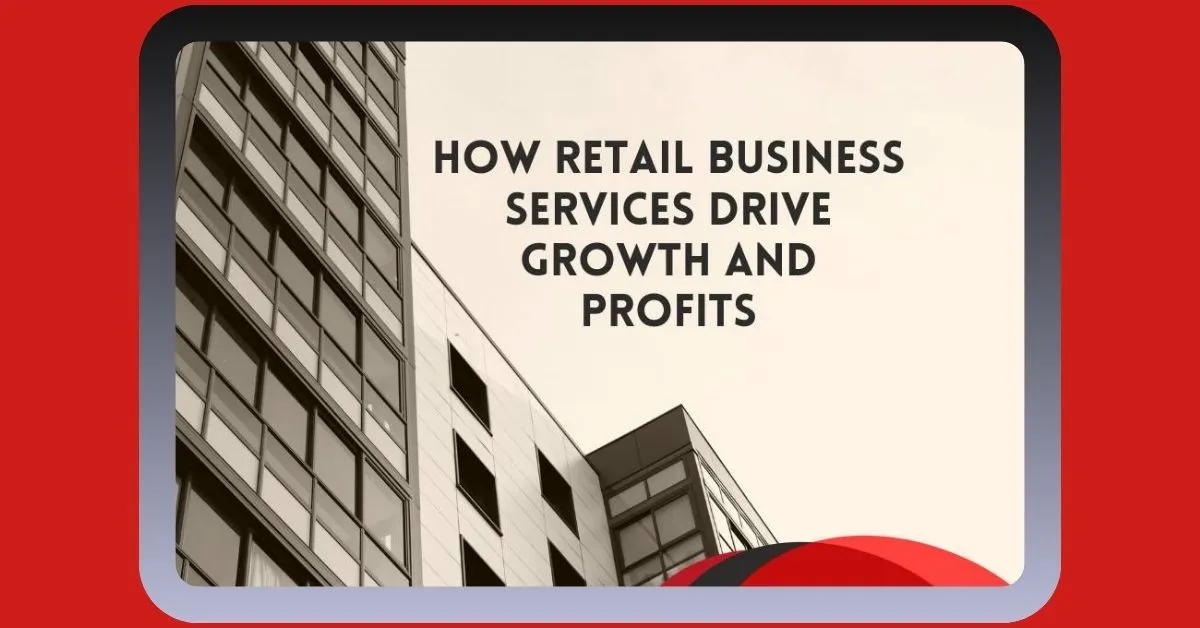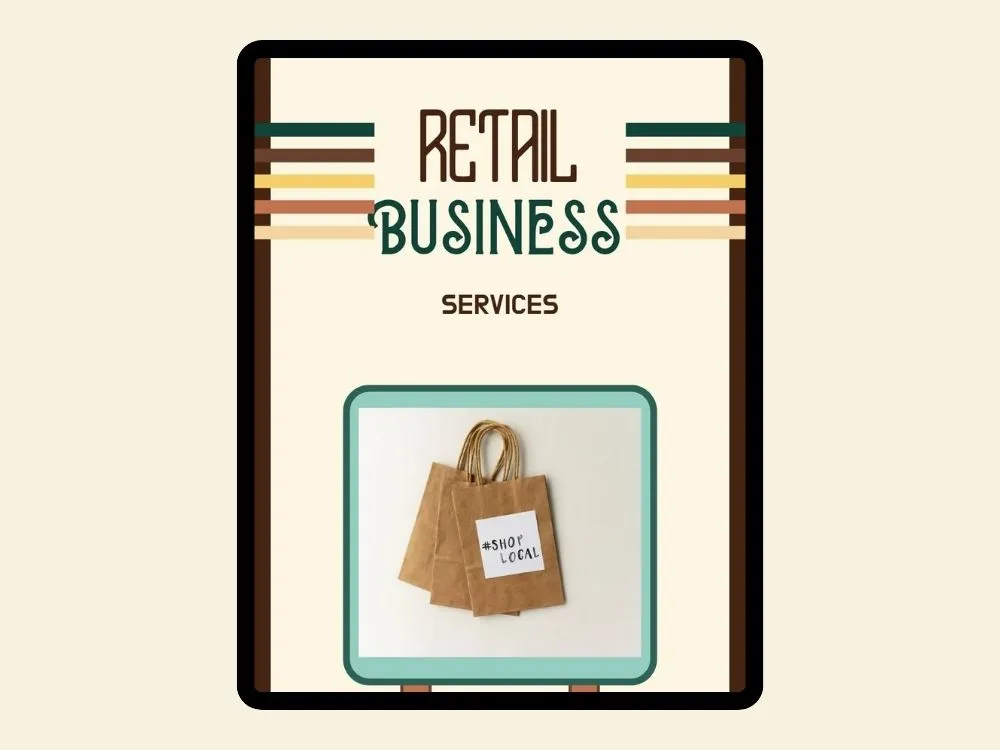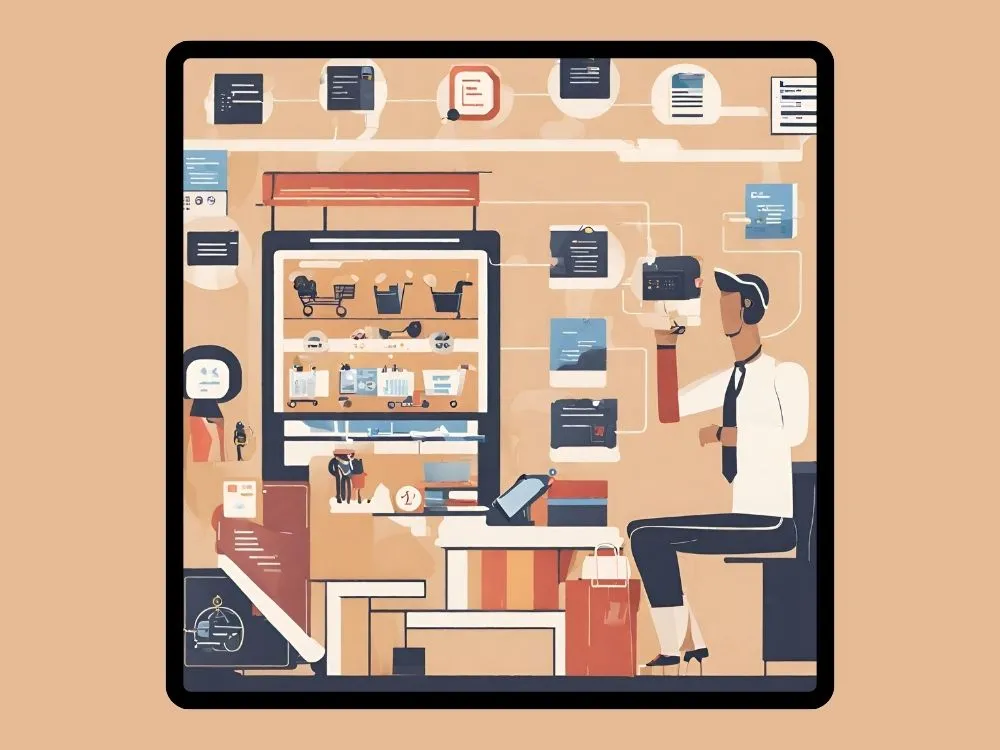
How Retail Business Services Drive Growth and Profits
A retail business is a kind of establishment that directly sells goods and services to customers to fulfill their consumption needs. Most of these retail businesses own a physical store for selling products and services, whereas some businesses also utilize online space to sell their products.
These days, a lot of stores are using both physical locations and online platforms to reach more customers. They usually have a ton of stuff to choose from, like groceries, clothes, electronics, household items, and more.
These businesses are super important for the supply chain because they connect manufacturers with customers. They also strive to make the best shopping experience for their customers by improving their store appearance, setting optimum prices, and offering good customer support.
Key Takeaways
- Understand how retail businesses directly connect manufacturers and customers through effective inventory management and product availability.
- Explore how advanced tools such as POS systems, CRM, and e-commerce solutions redefine customer experience and improve operational efficiency.
- Find out how retail business services help build customer loyalty, push repeat business, and drive positive word-of-mouth marketing.
- Understand how service alignments with brand values, plus utilizing data analytics boosts continuous improvement and competitive advantage.
- Measure the effectiveness of retail business services by analyzing KPIs like sales growth, customer satisfaction, and operational efficiency.

Importance of Retail Business Services
Retail business services are significant in today’s highly competitive market, where they function as a bridge between customers and manufacturers. They alleviate the time of the supply chain process and enable efficient inventory management. This ensures product availability at any time when the customers need it.
Likewise, these services incorporate point of sale (POS) systems that enable transactions and data analysis conveniently. Using the POS systems, businesses get real-time data insights, which helps them make informed business decisions.
Further, these services are vital to boost customer relationship management (CRM), where firms acquire customers’ data easily. It also helps implement marketing strategies, pricing, and other strategic decision-making processes to improve customer relationships.
Retail Business Services and Their Significance in The Industry
They offer a wide range of benefits that are significant to grow the business industry. Here are some common ways listed in a table that hold immense importance:
| Ways | Significance in the industry |
|---|---|
| Inventory Management | Ensures product availability, and reduces losses from stock issues. |
| Point-of-Sale (POS) Systems | Streamlines transactions, and provides vital sales data. |
| Customer Relationship Management (CRM) | Tailors marketing and enhances customer experiences. |
| E-commerce Solutions | Expands reach in the digital market space. |
| Payment Processing | Ensures secure and efficient transactions. |
| Supply Chain Optimization | Enhances sourcing, transportation, and distribution. |
| Analytics and Insights | Derives actionable data for strategic decisions. |
Retail Business Service Categories
They are categorized into several key areas. The following table clearly explains the categories of retail business services.
| Categories | Description |
|---|---|
| A. Operational Services | |
| Inventory Management | Track and optimize stock levels |
| Store Operations | Ensure smooth daily store functions |
| Staffing & Workforce Management | Recruit, train, and manage employees |
| Customer Support | Address customer inquiries and issues |
| B. E-commerce and Online Services | |
| E-commerce Platforms | Set up and manage online retail |
| Digital Marketing | Promote products and reach online customers |
| Payment Processing | Secure online payment handling |
| C. Supply Chain and Logistics Services | |
| Supply Chain Management | Optimize supplier-to-customer flow |
| Distribution and Warehousing | Efficient product storage and distribution |
| Transportation and Delivery | Shipping and last-mile delivery services |
| D. Data Analytics and Business Intelligence | |
| Data Analysis | Collect, process, and analyze retail data |
| Business Intelligence | Derive insights for decision-making |
| E. Marketing and Advertising Services | |
| Marketing Campaigns | Plan and execute marketing strategies |
| Visual Merchandising | Create appealing product displays |
| Advertising and Promotion | Engage customers via various channels |
| F. Security and Loss Prevention | |
| Loss Prevention | Prevent theft and fraud |
| Security Systems | Install and monitor security equipment |
| G. Technology Integration | |
| IT Solutions | Integrate tech solutions like mobile apps and AI |
| POS System Integration | Connect POS with other operations |
| H. Consulting and Advisory Services | |
| Retail Strategy Consulting | Expert guidance on strategies and trends |
| Financial and Legal Services | Handle retail finance and legal compliance |
Why Retail Business Services Matter
They are super important for keeping things running smoothly and making sure customers are happy. They help simplify processes, boost sales, and support overall business growth, which makes them a key part of winning in the retail industry.
Impact of Exceptional Services on Customer Satisfaction
As you know, retail business services provide exceptional customer support, which matters a lot for increasing customer satisfaction. Consumer behaviors are different from person to person, and it's crucial to match every customer's needs by providing exceptional services.
Retail business services let customers conveniently purchase products and services. This creates more room for them to engage with the business. Customer relationship management is vital to retain customers for a longer period, and these exceptional service provisions help ensure this.
How Positive Customer Experiences Lead to Repeat Business and Word-of-Mouth Marketing
Creating a positive customer experience is truly important for businesses to expand their market, retain customers, and lead to repeat business. Customer satisfaction is an invaluable asset because satisfied customers spread good things about the business and its products among their circle.
This word-of-mouth marketing is essential for organizations that bring several benefits to the company, free of cost. Retail business services offer the best customer experiences and enhance their satisfaction, which helps increase repeat business and profits to the company.
How Retail Business Services Enhance Customer Engagement and Retention
There are several ways retail business services play a major role in enhancing customer engagement and retention. Let's see how:
The Connection Between Customer Loyalty and Long-Term Growth
There is a strong connection between customer loyalty and a business's long-term growth. Loyal customers produce repeat business and are retained for the long term. This is simply because of the value of the products or services of a business that they consume.
This will create a strong brand presence and support for long-term growth and success. Further, loyal customers do free marketing for the business through word of mouth. They tell their family or colleagues about the specific characteristics they like in the product or service. This is useful to attract more customers to buy from the business.
Considering all these factors, businesses must understand the necessity of keeping loyal customers. Therefore, they utilize retail business services effectively to achieve this target.
Strategies for Implementing Effective Retail Business Services

Actionable Insights for Businesses
Implementing retail business services effectively requires a strategic approach that goes beyond the mere provision of services. Here are some actionable insights that help businesses enhance their service offerings and drive success:
- Understand Customer Needs: First, it's mandatory to thoroughly understand your target audience. Collect data, conduct surveys, and analyze feedback to identify their preferences and pain points.
- Personalization: Tailor your services to individual customer preferences whenever possible. Personalized recommendations, discounts, and experiences create a strong emotional connection.
- Invest in Training: Train employees in customer service excellence. Well-trained staff can deliver better service that helps increase customer satisfaction and loyalty.
- Seamless Integration: Ensure that the services you offer are seamlessly integrated into your business operations. Whether it's an e-commerce platform, a POS system, or a CRM, it should work better.
- Regularly Update Technology: Keep your technology up to date to meet evolving customer expectations. Mobile apps, secure payment processing, and online shopping experiences should align with the latest trends.
- Feedback Loops: Establish feedback mechanisms to gather input from customers and employees. This feedback helps make continuous improvements.
- Loyalty Programs: Implement loyalty programs that reward and incentivize repeat business. These programs should be easy to understand and offer tangible benefits.
- Multi-Channel Engagement: Create a cohesive experience across all customer touchpoints, whether in-store or online. Consistency in messaging and service is crucial.
- Data Security: Ensure the highest level of security for customer data, especially in online transactions. Trust is very crucial for creating long-term relationships.
- Monitor Competition: Keep an eye on competitors and industry trends. Benchmark your services against the best in the industry to identify areas for improvement.
- Sustainability Initiatives: Incorporate sustainability practices into your service offerings. Showcasing environmental responsibility resonates with socially conscious customers.
- Legal Compliance: Stay up to date with retail regulations and legal requirements. Compliance ensures trust and avoids potential issues.
- Test and Iterate: Don't be afraid to experiment with new services or strategies. Regularly test and iterate based on results and customer feedback.
- Transparent Communication: Maintain open and transparent communication with customers, especially when implementing changes to your services.
- Employee Feedback: Encourage employees to provide insights on improving services since they often have valuable frontline perspectives.
By incorporating these insights into your business strategy, you not only offer effective retail business services but also continuously adapt and innovate to meet the evolving needs and expectations of your customers.
The Alignment of Retail Business Services with The Brand Values and Mission
It's necessary to ensure that retail business services align with what a business brand stands for. The table below clearly explains the steps for aligning retail services with a business brand's values and mission.
Steps | Description |
|---|---|
| 1. Understand Your Brand | Define what your brand represents |
| 2. Identify Key Touchpoints | Find where your services impact your brand most |
| 3. Train Your Team | Teach staff your brand's values |
| 4. Be Consistent | Keep services aligned with your brand's mission |
| 5. Prioritize Customers | Focus on meeting customer needs |
| 6. Match Products and Presentation | Choose products and displays in line with your brand |
| 7. Message Right | Ensure marketing reflects your brand's values |
| 8. Sustainability and Ethics | Reflect ethical and environmental values |
| 9. Connect with Your Community | Engage with the community through your services |
| 10. Listen and Improve | Continually gather feedback and make improvements |
Measuring the ROI of Retail Business Services
Measuring return on investment (ROI) is essential for evaluating the effectiveness of processes, highlighting both strengths and areas for improvement. This enables businesses to optimize resource allocation and enhance overall performance.
Methods for Assessing the ROI for Service Improvements
Assessing the ROI is crucial for retail service improvements. Some renowned methods are followed, such as:
- Sales and Revenue Analysis: Compare sales and revenue data before and after implementing the service improvements. Calculate the average increase in revenue attributable to these changes, factoring in the cost of improvements.
- Customer Feedback and Satisfaction Surveys: Collect customer feedback to measure their satisfaction levels. Higher satisfaction correlates with increased spending and loyalty, which contributes to better ROI.
- Customer Retention Rates: Analyze the customer retention rates to decide if service enhancements are preserving existing customers from coming back.
- Customer Acquisition Costs: Calculate the cost of getting new customers after service improvements. Lower acquisition costs positively impact ROI.
- Average Transaction Value: Monitor changes in the average transaction value after implementing service improvements. If customers spend more per visit, it can boost ROI.
- Customer Lifetime Value (CLV): Assess whether service enhancements increase CLV, meaning that customers are more valuable over their lifetime.
- Competitive Advantage: Evaluate how service enhancements position your brand against competitors. It positively impacts ROI if the improvements lead to a competitive edge.
- Cost-Benefit Analysis: Conduct a comprehensive cost-benefit analysis, considering both tangible and intangible benefits against the investments made in service improvements.
- Operational Efficiency: Measure improvements in operational efficiency, such as reduced staff turnover, shorter service times, or inventory management optimization. Efficiency gains significantly reduce operational costs and contribute to ROI.
- Return Visits and Loyalty Programs: Monitor the frequency of return visits and participation in loyalty programs. These metrics show customer engagement and impact ROI.
- Social Media and Online Reviews: Track online mentions, reviews, and social media sentiment related to service improvements. A positive online presence attracts more customers and drives ROI.
- Time-to-Value: Determine the time it takes to realize the full benefits of service improvements. A shorter time-to-value leads to quicker ROI.
- Benchmarking: Compare your ROI with industry benchmarks to review your performance relative to competitors.
By employing these methods, retail businesses gain a comprehensive understanding of how service enhancements impact their bottom line and make data-driven decisions for further improvements.
The Connection Between Improved Services, Customer Satisfaction, and Increased Profits
There is a robust interconnection between good retail business services, customer satisfaction, and profit improvement. When a retail business improves its service provision, customers tend to get a sophisticated shopping experience. This makes them get all vital services from the business due to satisfaction.
When customers are satisfied with the business services, they are more likely to tell their friends and family, which brings new sales prospects. Also, the customers remain loyal to the business, which helps make more business through closing more deals and increasing profits.
Case Studies: Real-Life Success Stories
Here we can find some real-life examples of retail businesses that showcase how they have harnessed retail business services to develop their operations, increase customer loyalty, and achieve remarkable growth:
- Walmart: A renowned multinational retail company that has utilized the power of technology and data analytics to optimize inventory management, supply chain, and customer service. In addition, their investment in online services such as grocery delivery and curbside pickup has greatly contributed to their business growth.
- Starbucks: A famous coffeehouse chain that leverages mobile app technology for order-ahead and payment services. This kind of business service enhances customer convenience and loyalty, which fuels their expansion and revenue growth.
- Sephora: A cosmetics retailer that excels in personalized customer experiences through their Beauty Insider loyalty program and in-store services like makeup consultations and beauty classes. Sephora's top commitment to exceptional service has helped its growth in the beauty industry.
Challenges and Solutions

Potential Challenges in Implementation
Effective retail business services provide ample benefits to the business. However, it's not without its challenges. Here are some potential hurdles businesses might face:
- Costs: Investing in service improvements can be expensive. Prices include staff training, technology upgrades, and process changes. Small businesses may struggle to allocate resources.
- Resistance to Change: Employees may resist changes to established processes. It can take time to overcome resistance and get everyone on board with new service strategies.
- Consistency Across Locations: Retail chains often face the challenge of maintaining consistent service quality across multiple locations, which can impact brand reputation.
- Data Security and Privacy: Gathering and using customer data for service personalization must comply with privacy regulations. Mishandling customer data leads to legal and reputational issues.
- Technology Integration: Integrating new technology with existing systems can be complex. Compatibility issues or downtime during transitions can disrupt operations.
- Customer Expectations: As services improve, customer expectations may rise. Meeting and exceeding these expectations consistently can be demanding.
- Competitive Pressure: Rivals may also enhance their services, intensifying the competition. Staying ahead can be challenging.
- Training and Staff Turnover: Consistently trained and motivated staff are crucial for effective services. High turnover rates hinder service quality.
- Negative Feedback: Implementing changes may result in initial negative feedback from customers. Managing this and maintaining trust are essential.
- Supply Chain Disruptions: Events like disruptions or pandemics can affect service delivery by causing product shortages or delivery delays.
- Legal Compliance: Adhering to business legal and regulatory requirements, such as food safety or consumer protection laws, is complex and costly.
- Balancing Automation: While task automation improves efficiency, businesses must strike a balance to avoid losing the personal touch customers appreciate.
Practical Solutions and Strategies to Overcome These Challenges
Eradicating the above challenges is vital for businesses to improve the provision of retail business services and lead to sustainable growth. The table below clearly shows how every challenge is successfully handled and eliminated:
Challenges | Practical Solutions |
|---|---|
1. Costs | a) Budget Allocation: Plan and allocate a budget for service improvements |
| b) ROI Analysis: Conduct ROI analysis to prioritize projects with significant returns | |
2. Resistance to Change | a) Clear Communication: Communicate reasons for changes and benefits clearly |
| b) Training and Support: Provide adequate training and ongoing support to employees | |
3. Consistency Across Locations | a) Standardization: Develop service protocols and training programs to ensure consistency |
| b) Mystery Shopping: Implement mystery shopping programs for evaluation and maintenance of consistency | |
4. Data Security and Privacy | a) Compliance: Stay updated with data protection regulations and ensure compliance |
| b) Data Encryption: Invest in strong data encryption and security measures. | |
5. Technology Integration | a) Integration Planning: Develop a complete integration plan with testing phases |
| b) IT Support: Ensure access to IT support for issue resolution during technology transitions | |
6. Customer Expectations | a) Market Research: Monitor customer trends and preferences for adapting services |
| b) Feedback Channels: Encourage customer feedback for service adjustments | |
7. Competitive Pressure | a) Continuous Innovation: Stay ahead through innovation and emerging tech |
| b) Market Analysis: Regularly analyze the competitive landscape | |
8. Training and Staff Turnover | a) Invest in Training and offer PTO: Prioritize staff training and development. Plus, offer adequate paid time off (PTO) to make workers happy. |
| b) Recognition and Rewards: Implement recognition and reward programs for better employee engagement and lees turnover | |
9. Negative Feedback | a) Proactive Response: Address negative feedback instantly |
| b) Service Recovery: Develop a service recovery protocol | |
10. Supply Chain Disruptions | a) Diversify Suppliers: Reduce reliance on a single source |
| b) Supply Chain Visibility: Invest in visibility tools for proactive disruption identification | |
11. Legal Compliance | a) Compliance Team: Appoint a dedicated compliance team |
| b) Regular Audits: Conduct regular audits to ensure compliance | |
12. Balancing Automation | a) Customer-Centric Automation: Focus on automation that enhances the customer experience |
| b) User-Friendly Interfaces: Ensure user-friendly automation interfaces |
Wrapping Up
Retail business services have been constantly evolving, which helps businesses drive more profits and sustainable growth. They offer several business services that produce various advantages in different ways, like enhancing customer relationships, good inventory management, enhanced sales, productivity, and many other benefits.
So many strategies are followed to implement effective retail services, such as understanding customer needs, investing in training, seamless integration, regularly updating technology, and many others.
Measuring the ROI of retail business services is crucial, as different methods are used to measure ROI. There are various challenges businesses face when implementing these services, and eliminating these challenges is vital, which requires certain strategies.
FAQs
Q1: What do retail business services do in the industry, and why is it important?
They help connect customers and manufacturers and enhance supply chain processes and other essential functions to establish business growth.
Q2. Why is measuring ROI important for retail business services?
ROI measurement is important to find out how financially successful these services are. Also, businesses can understand the return on investment they made on these services.
Q3: How can businesses successfully face and evade retail business challenges?
Implementing practical and strategic solutions helps evade these challenges, and businesses can thrive in the competitive retail market.
Explore Related Posts
https://smarttoolsai.com/post/practical-uses-of-a-discount-calculator-in-different-business-sectors
https://smarttoolsai.com/post/kyb-know-your-business-regulations-processes-and-best-practices
.webp)